October 2005 lunar eclipse
Partial lunar eclipse 17 October 2005 From Wikipedia, the free encyclopedia
A partial lunar eclipse occurred at the Moon’s ascending node of orbit on Monday, October 17, 2005,[1] with an umbral magnitude of 0.0645. A lunar eclipse occurs when the Moon moves into the Earth's shadow, causing the Moon to be darkened. A partial lunar eclipse occurs when one part of the Moon is in the Earth's umbra, while the other part is in the Earth's penumbra. Unlike a solar eclipse, which can only be viewed from a relatively small area of the world, a lunar eclipse may be viewed from anywhere on the night side of Earth. Occurring about 3.1 days before perigee (on October 14, 2005, at 10:00 UTC), the Moon's apparent diameter was larger.[2]
| Partial eclipse | |||||||||||||
 Partiality as viewed from Taipei, Taiwan, 12:04 UTC | |||||||||||||
| Date | October 17, 2005 | ||||||||||||
|---|---|---|---|---|---|---|---|---|---|---|---|---|---|
| Gamma | 0.9796 | ||||||||||||
| Magnitude | 0.0645 | ||||||||||||
| Saros cycle | 146 (10 of 72) | ||||||||||||
| Partiality | 55 minutes, 58 seconds | ||||||||||||
| Penumbral | 259 minutes, 49 seconds | ||||||||||||
| |||||||||||||
Visibility
The eclipse was completely visible much of Australia, east Asia, and western North America, seen rising over much of Asia and setting over much of North America and western South America.[3]
 |
 Hourly motion shown right to left |
 The Moon's hourly motion across the Earth's shadow in the constellation of Pisces. |
 Visibility map | ||
Images

Gallery
- Akita City, Japan, 12:21 UTC
Eclipse details
Shown below is a table displaying details about this particular lunar eclipse. It describes various parameters pertaining to this eclipse.[4]
| Parameter | Value |
|---|---|
| Penumbral Magnitude | 1.06046 |
| Umbral Magnitude | 0.06446 |
| Gamma | 0.97960 |
| Sun Right Ascension | 13h29m41.7s |
| Sun Declination | -09°23'29.0" |
| Sun Semi-Diameter | 16'03.1" |
| Sun Equatorial Horizontal Parallax | 08.8" |
| Moon Right Ascension | 01h27m54.2s |
| Moon Declination | +10°15'01.0" |
| Moon Semi-Diameter | 16'06.9" |
| Moon Equatorial Horizontal Parallax | 0°59'08.7" |
| ΔT | 64.8 s |
Eclipse season
This eclipse is part of an eclipse season, a period, roughly every six months, when eclipses occur. Only two (or occasionally three) eclipse seasons occur each year, and each season lasts about 35 days and repeats just short of six months (173 days) later; thus two full eclipse seasons always occur each year. Either two or three eclipses happen each eclipse season. In the sequence below, each eclipse is separated by a fortnight.
| October 3 Descending node (new moon) | October 17 Ascending node (full moon) |
|---|---|
 |  |
| Annular solar eclipse Solar Saros 134 | Partial lunar eclipse Lunar Saros 146 |
Related eclipses
Summarize
Perspective
Eclipses in 2005
- A hybrid solar eclipse on April 8.
- A penumbral lunar eclipse on April 24.
- An annular solar eclipse on October 3.
- A partial lunar eclipse on October 17.
Metonic
- Preceded by: Lunar eclipse of December 30, 2001
- Followed by: Lunar eclipse of August 6, 2009
Tzolkinex
- Preceded by: Lunar eclipse of September 6, 1998
- Followed by: Lunar eclipse of November 28, 2012
Half-Saros
- Preceded by: Solar eclipse of October 12, 1996
- Followed by: Solar eclipse of October 23, 2014
Tritos
- Preceded by: Lunar eclipse of November 18, 1994
- Followed by: Lunar eclipse of September 16, 2016
Lunar Saros 146
- Preceded by: Lunar eclipse of October 7, 1987
- Followed by: Lunar eclipse of October 28, 2023
Inex
- Preceded by: Lunar eclipse of November 6, 1976
- Followed by: Lunar eclipse of September 28, 2034
Triad
- Preceded by: Lunar eclipse of December 17, 1918
- Followed by: Lunar eclipse of August 17, 2092
Lunar eclipses of 2002–2005
This eclipse is a member of a semester series. An eclipse in a semester series of lunar eclipses repeats approximately every 177 days and 4 hours (a semester) at alternating nodes of the Moon's orbit.[5]
The penumbral lunar eclipse on June 24, 2002 occurs in the previous lunar year eclipse set.
| Lunar eclipse series sets from 2002 to 2005 | ||||||||
|---|---|---|---|---|---|---|---|---|
| Descending node | Ascending node | |||||||
| Saros | Date Viewing |
Type Chart |
Gamma | Saros | Date Viewing |
Type Chart |
Gamma | |
| 111 | 2002 May 26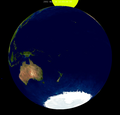 |
Penumbral |
1.1759 | 116 | 2002 Nov 20 |
Penumbral |
−1.1127 | |
121 |
2003 May 16 |
Total |
0.4123 | 126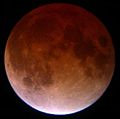 |
2003 Nov 09 |
Total |
−0.4319 | |
131 |
2004 May 04 |
Total |
−0.3132 | 136 |
2004 Oct 28 |
Total |
0.2846 | |
| 141 | 2005 Apr 24 |
Penumbral |
−1.0885 | 146 |
2005 Oct 17 |
Partial |
0.9796 | |
Metonic series
The Metonic cycle repeats nearly exactly every 19 years and represents a Saros cycle plus one lunar year. Because it occurs on the same calendar date, the Earth's shadow will in nearly the same location relative to the background stars.
| Descending node | Ascending node | |||||
|---|---|---|---|---|---|---|
| Saros | Date | Type | Saros | Date | Type | |
| 111 | 1948 Apr 23 | Partial | 116 | 1948 Oct 18 | Penumbral | |
 |
 | |||||
| 121 | 1967 Apr 24 | Total | 126 | 1967 Oct 18 | Total | |
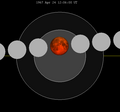 |
 | |||||
| 131 | 1986 Apr 24 | Total | 136 | 1986 Oct 17 | Total | |
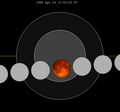 |
 | |||||
| 141 | 2005 Apr 24 | Penumbral | 146 | 2005 Oct 17 | Partial | |
 |
 | |||||
Saros 146
This eclipse is a part of Saros series 146, repeating every 18 years, 11 days, and containing 72 events. The series started with a penumbral lunar eclipse on July 11, 1843. It contains partial eclipses from October 17, 2005 through May 14, 2348; total eclipses from May 25, 2366 through November 16, 2654; and a second set of partial eclipses from November 27, 2672 through June 12, 2997. The series ends at member 72 as a penumbral eclipse on August 29, 3123.
The longest duration of totality will be produced by member 37 at 99 minutes, 22 seconds on August 8, 2492. All eclipses in this series occur at the Moon’s ascending node of orbit.[6]
| Greatest | First | |||
|---|---|---|---|---|
| The greatest eclipse of the series will occur on 2492 Aug 08, lasting 99 minutes, 22 seconds.[7] | Penumbral | Partial | Total | Central |
| 1843 Jul 11 |
2005 Oct 17 |
2366 May 25 |
2438 Jul 07 | |
| Last | ||||
| Central | Total | Partial | Penumbral | |
| 2546 Sep 11 |
2654 Nov 16 |
2997 Jun 12 |
3123 Aug 29 | |
Eclipses are tabulated in three columns; every third eclipse in the same column is one exeligmos apart, so they all cast shadows over approximately the same parts of the Earth.
| Series members 1–20 occur between 1843 and 2200: | |||||
|---|---|---|---|---|---|
| 1 | 2 | 3 | |||
| 1843 Jul 11 | 1861 Jul 21 | 1879 Aug 02 | |||
| 4 | 5 | 6 | |||
| 1897 Aug 12 | 1915 Aug 24 | 1933 Sep 04 | |||
 |
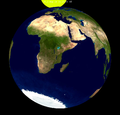 |
 |
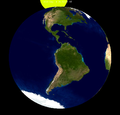 | ||
| 7 | 8 | 9 | |||
| 1951 Sep 15 | 1969 Sep 25 | 1987 Oct 07 | |||
 |
 |
 |
 |
 |
 |
| 10 | 11 | 12 | |||
| 2005 Oct 17 | 2023 Oct 28 | 2041 Nov 08 | |||
 |
 |
 |
 |
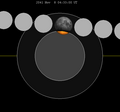 |
 |
| 13 | 14 | 15 | |||
| 2059 Nov 19 | 2077 Nov 29 | 2095 Dec 11 | |||
 |
 |
||||
| 16 | 17 | 18 | |||
| 2113 Dec 22 | 2132 Jan 02 | 2150 Jan 13 | |||
| 19 | 20 | ||||
| 2168 Jan 24 | 2186 Feb 04 | ||||
Tritos series
This eclipse is a part of a tritos cycle, repeating at alternating nodes every 135 synodic months (≈ 3986.63 days, or 11 years minus 1 month). Their appearance and longitude are irregular due to a lack of synchronization with the anomalistic month (period of perigee), but groupings of 3 tritos cycles (≈ 33 years minus 3 months) come close (≈ 434.044 anomalistic months), so eclipses are similar in these groupings.
| Series members between 1801 and 2147 | |||||||||
|---|---|---|---|---|---|---|---|---|---|
| 1809 Apr 30 (Saros 128) |
1820 Mar 29 (Saros 129) |
1831 Feb 26 (Saros 130) |
1842 Jan 26 (Saros 131) |
1852 Dec 26 (Saros 132) | |||||
| 1863 Nov 25 (Saros 133) |
1874 Oct 25 (Saros 134) |
1885 Sep 24 (Saros 135) |
1896 Aug 23 (Saros 136) |
1907 Jul 25 (Saros 137) | |||||
 |
 | ||||||||
| 1918 Jun 24 (Saros 138) |
1929 May 23 (Saros 139) |
1940 Apr 22 (Saros 140) |
1951 Mar 23 (Saros 141) |
1962 Feb 19 (Saros 142) | |||||
 |
 |
 |
 |
 |
 |
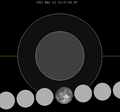 |
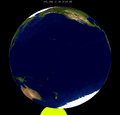 |
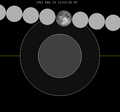 |
 |
| 1973 Jan 18 (Saros 143) |
1983 Dec 20 (Saros 144) |
1994 Nov 18 (Saros 145) |
2005 Oct 17 (Saros 146) |
2016 Sep 16 (Saros 147) | |||||
 |
 |
 |
 |
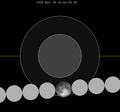 |
 |
 |
 |
 |
 |
| 2027 Aug 17 (Saros 148) |
2038 Jul 16 (Saros 149) |
2049 Jun 15 (Saros 150) |
|||||||
 |
 |
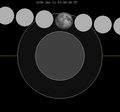 |
 |
 |
 |
||||
| 2114 Dec 12 (Saros 156) |
|||||||||
| 2147 Sep 09 (Saros 159) | |||||||||
Inex series
This eclipse is a part of the long period inex cycle, repeating at alternating nodes, every 358 synodic months (≈ 10,571.95 days, or 29 years minus 20 days). Their appearance and longitude are irregular due to a lack of synchronization with the anomalistic month (period of perigee). However, groupings of 3 inex cycles (≈ 87 years minus 2 months) comes close (≈ 1,151.02 anomalistic months), so eclipses are similar in these groupings.
| Series members between 1801 and 2200 | |||||
|---|---|---|---|---|---|
| 1803 Mar 08 (Saros 139) |
1832 Feb 16 (Saros 140) |
1861 Jan 26 (Saros 141) | |||
| 1890 Jan 06 (Saros 142) |
1918 Dec 17 (Saros 143) |
1947 Nov 28 (Saros 144) | |||
 |
 |
 |
 | ||
| 1976 Nov 06 (Saros 145) |
2005 Oct 17 (Saros 146) |
2034 Sep 28 (Saros 147) | |||
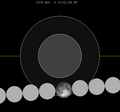 |
 |
 |
 |
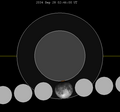 |
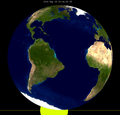 |
| 2063 Sep 07 (Saros 148) |
2092 Aug 17 (Saros 149) |
2121 Jul 30 (Saros 150) | |||
| 2150 Jul 09 (Saros 151) |
2179 Jun 19 (Saros 152) | ||||
Half-Saros cycle
A lunar eclipse will be preceded and followed by solar eclipses by 9 years and 5.5 days (a half saros).[8] This lunar eclipse is related to two partial solar eclipses of Solar Saros 153.
| October 12, 1996 | October 23, 2014 |
|---|---|
 |
 |
See also
References
External links
Wikiwand - on
Seamless Wikipedia browsing. On steroids.

